
| Patrons
and Patronage
Summary: How open to black architects is access to the white patron establishment, what progress has occurred, and what still remains to be done? Read opinions by black practitioners from various parts of the nation along with comments by a major patron. Instead of resting in a few autocratic hands, architect selection has been spread over a great surface, determined by innumerable top and middle executives, committees, college presidents, museum directors, boards of directors; second guessed by multiple review boards, mortgage lenders, bankers, insurance companies, and the bond-voting electorate; and in the end praised or condemned by battalions of building users, visitors, maintenance staffs, passers by, and professional critics. This system has worked very well for established design firms and for rising firms with the right credentials. It has had the opposite effect on the fortunes of black architects, leaving them impatiently waiting to come in from the cold of exclusion into the warm precincts of acceptance and good connections. As a result, a very high volume of work by black architects has come to them from within the black community and from set asides. This has meant on the one hand an architectural diet mostly of schools, churches, and local community centers, rich in personal fulfillment, but thin in fee income and unpredictable as to volume. Moreover, such structures do not demand the resources of a very large firm, and the firm that can easily prepare contract documents and construction administration services for delivering an elementary school will be stretched to do the same for a 30-story office building or a $40 million museum. On the other hand, set-aside programs have offered minority architects the first step up the ladder to success. The disadvantages of modest size and limited resources have not been lost on the white patron establishment that commissions America’s largest and most significant buildings. Tales abound of black-owned firms not invited to submit credentials due to their size, most recently in the selection of a well-known majority architect to design the National Museum of African Art on 110th Street in Manhattan. One cannot fault owners if that has been the sole cause for rejection. The phenomenon isn’t limited to the private patron, whose circle is hardest for the black architect to penetrate. The public client, too—from federal agencies and state construction authorities all the way to city and township departments of design and construction, and local school boards—admit, when asked, to this form of discrimination, citing doubt about the black architect’s resources of people, technology, and capital being capable of delivering the work on time, on budget, and at the desired level of quality.
Until recently, about the only patron many black firms see in today’s culture is the black church. It is the one entity able to raise money. Most of the development in Harlem, for example, had been through the black churches. Today, developers have sponsored retail and high-rise residential building, mostly along 116th and 125th Streets, but the designers have been for the most part white, with a black cultural consultant retained in some cases to advise on African-derived features.
“These days there are people like Oprah Winfrey and Bill Cosby who have billions of dollars to spend, and they’ll say ‘I didn’t know about black architects, I’ll hire a white one.’ I’m not suggesting you hire me simply because I’m black. I’m just saying there are lots of possibilities, and I would say to them: ‘I would expect you of all people to explore them all. Go look at lots of architects' work, but in the end you‘ll know that you settled on one architect because you saw the work and you wanted that architect to do your house, not because ‘I didn’t know any black architects.’” Author’s note: As we go to posting, a dispute has arisen as to whether an Asian sculptor is the right artist to sculpt a life-size likeness of Dr Martin Luther King Jr. for the King Memorial in Washington. Likewise, as reported by the New York Times in January 2001, a black New Jersey businessman, Jack Butler, instead of looking for a black architect to renovate and expand his North Jersey house to twice its size, ended up hiring a newly immigrated architect from Central Europe recommended by a builder he knew. The architect designed a house made up of a prodigious array of large clashing forms, wrote Times reporter Trish Hall, but lacking any visible or implied use of African-derived elements. Butler had been president, for eight years, of the New York chapter of the elite African American Society 100 Black Men of America, Inc., where he had socialized with such eminent African Americans as Colin Powell, Magic Johnson, and Harry Belafonte. Unlike Bill Cosby, who is known for his efforts to hire black architects to house his charitable activities, black citizens such as Butler, Evander Holyfield, and others find it is simpler to hire majority architects introduced to them by their advisers or a friendly builder. Of course there is no law in the land that places upon black patrons any obligation to retain architects from their own race. But given the high hurdles faced by most black practitioners to move broadly beyond the set asides of public work, such potential patrons could take advantage of every opportunity to do black architects a good turn, at no risk whatever. But there is hope, notes Jackson Preston: “We’re getting closer to people like Sean Combs (better known as Diddy) and Chris Rock, and they’re going to hire somebody black. They hire somebody black and you do a good job, and they’re highly visible [patrons], so more barriers get broken. Look at [the late] Johnny Cochran in the O.J. Simpson trial. Whatever you think about it, he did so much for black people in terms of saying that you can hire a black lawyer. Before you could not convince a black man who was in trouble to hire a black lawyer. They thought you had to be a white, Jewish attorney. Johnny Cochran convinced black people you can hire a black lawyer, and you’ll be OK. He broke that barrier in one case, boom! On the same lines, D.C. attorney Bill Martin has clients as diverse as Michael Vick and now Idaho Senator Larry Craig. “That has to happen architecturally. You get that opportunity, and you do a very good job, and then they go ‘Oh! It’s OK to hire a black architect.’ You need a high profile commission. Like winning a major competition.” New York’s black architects look askance at the building boom under way in Harlem. Most of the work has been picked up by white architects, and its general quality is undistinguished, despite one or two excellent projects. Jackson Preston’s comment: “I’m not saying that you should hire me. I say that with all those dollars you’re spending uptown you could get some real design work done. Because those white architects are being paid top dollar. They are coming uptown and getting into a community they know nothing about . . . And there are people like me who have been up here, sweating and trying really to do a good job, and have a really broad, well-founded understanding of this community, and know where and how to push the envelope, who just don’t have the opportunity. Because we’re still in this mold of ‘get the white architect so it will be done well.’ And the truth is that’s not always true.”
“I say ‘no.’ Black progress may depend on focusing on those areas that make any firm grow: expertise in certain project types and marketing around that expertise . . . The 15-25 percent set aside should be used sparingly and strategically. Black architects should be wary of becoming comfortable with a small piece, for it means you forego plotting to get the 85-75 percent piece. “Gone are the days when a passive practice (‘I am a black architect’) is rewarded by an activist government (‘We must reward black architects’). I see it replaced by an active practice (‘I am a black architect aggressively looking in every corner I can for work’) that may be rewarded by patrons public and private, which have lately taken up the notion of fairness (‘We are all equal, and we would like to see our largesse spread around more equitably’). “After five years of tough-minded active practice, you may find yourself talking with a stranger in an airport who needs an architect with your expertise. But don't count on it. Depend on your network and yourself, build your expertise—sometimes with partners but mostly without—and show your work. God bless her forever, but don't wait for Oprah.”
Lee also questions the fairness of holding young white firms and any black firm to different standards of selection. “MIT,” he says, “has had some high profile architects come in way late and over budget. That leads one to feel that [MIT’s] doubts about capacity, timeliness, and budget don’t seem to apply to so-called ‘rising’ young firms or ‘star’ architects when choosing architects.” “Despite the successes our firm has managed over the years, it has been a struggle;” he adds, “a lot of finishing second, which often is more about making the process seem legitimate than really aiming to think outside of the box to see whether or not a minority firm might be a legitimate possibility. “At some point, people at the top are going to have to be as willing to take a chance with black firms (and our abilities to put together the right teams if necessary) as they are with the young white architects who are dubbed the stars of the future. The selection committee for the new Museum of Contemporary Art in Boston reportedly said they were excited about giving the firm they hired [Diller Scofidio +Renfro] their first chance to do a major building. Many clients are willing to take a chance with unproven white firms but never with black firms, even those with a solid body of work. “I agree on the dismal record of black athletes, celebrities, and captains of industry in hiring black architects. Not knowing is not a legitimate excuse.” Affirmative action/set asides The notion of set asides has not gone unchallenged. The argument used to rescind them has been that they allegedly violated the equal protection clause of the 14th amendment, and that plaintiffs often failed to prove there was a systemic lack of opportunity to propose or bid on private contracts. In practice, set asides have helped bring more black firms into the arena, and most black firms, including successful ones that do not take on such work, favor retention. It has given younger firms the chance to see their work designed and built, sometimes published, and adding something solid to their portfolio. The number of minority-owned firms, defined as architectural businesses at least 51 percent owned and controlled by minorities, and hence eligible for set asides, declined to 5.6 percent from 7 percent in the period ending 2003, according to that year’s AIA Business of Architecture report. Set asides, federal and local, accounted for a small percentage of billings for most firms. Of firms with 100 or more staff, none accrued more than 20 percent of their billings from set asides. By contrast, 12.5 percent of sole practitioners cited 91 to 100 percent of their billable came from set asides. And set asides granted by the public patron have not been an unqualified blessing. Established majority firms have used set asides as sharp wedges to pry open the vault of extra work. To be eligible for such projects, majority firms must allocate a designated percentage of the fee to a minority-owned firm. Whenever the fee share allocated to the black firm buys a substantive contribution to the project—whether in design, production, or field administration—such set asides have been a good thing. But unscrupulous majority firms have been known to link up with a black firm to get the work, pay the black firm its share of the fee, then give it nothing meaningful to do. This adds insult to injury. Not only does it fail to enhance the black firm's reputation, it actually degrades it. Incensed over the subsidiary roles to which black architects are often relegated as team members of an alliance or joint venture, “when the majority firm is calling the shots when assembling a team—the typical scenario—it is tough to negotiate meaty roles for the minority member of the team,” Lee contends. Minority firms that avail themselves of set asides are few. Only 2 percent of minority firms report more than half their workloads came from set asides—according to Pradeep Dalal, formerly AIA’s director of economics and market research. Another 2 percent attribute 25 to 49 percent of their work to set asides, and 5 percent admit to less than 25 percent. The balance declared not having any set-aside-derived work on their boards. Many emerging firms, for whom set asides were designed to help, claim there is no profit in it because of the overwhelming paper work and documentation required. By 2007, the nation has produced successful African-American practices in most regions of the nation, but especially in certain cities. One fruitful case is Atlanta. As a Southern city, Atlanta has always had a tightly knit black community with roots going back generations. The racial struggle in the South had given a strong impetus to black entrepreneurship, in particular to professions that were closed in those days to blacks except when practiced in the black community, such as medicine, teaching, design, and construction. In Atlanta, civil rights changed all that. So when the voters, finally converting their huge residential majority into voting muscle, by voting in, for the first time, black mayors, such as Andrew Young and Maynard Jackson, the business prospects of blacks zoomed. Three-term mayor Maynard Jackson was a pragmatic man who knew political power means nothing without economic power. He quickly launched and enforced stringent affirmative action: Any developer or investor who wanted to do business with the City of Atlanta had to have minority firms well represented. Those years saw the beginnings of such architecture firms as R. L. Brown Associates , Stanley Love-Stanley , and the successful general contractor Herman Russell. The black and the white communities, well organized and in regular contact, were happy to acknowledge those facts of political and economic life. In New York, Los Angeles, Boston, and Chicago, black firms have faced tougher going than in Atlanta. One explanation lies in the degree of cohesiveness of the black and white power structures. In New York, for example, the black community is both more diffuse—and far less numerous than in Atlanta, with 29 percent of the population compared to 75 percent in Atlanta. New Yorkers have elected only one black mayor (David Dinkins, 1989-1993). The Dinkins impact on the fortunes of black architects was unremarkable. A model of a successful black architect whose success was driven mainly by the black community but never quite achieved the breakthrough to major private work was Harry Simmons, a Brooklyn-based architect who depended for his income on churches, school work, and renovations. Simmons had built up a sizable church clientele. The materials and structural systems of Simmons’ churches differed little, allowing him to produce a large volume of work, which made him rich. (His prosperity was partially responsible for his downfall. He owned and flew a small plane, which crashed one day and killed him). Being ‘in the area of gossip’ Johnson was himself a self-made man who arrived in Chicago from the small Mississippi River town of Arkansas City, Ark., at the age of 15. He made his first million a few years later by publishing Negro Digest, a magazine that hit a huge responsive chord among blacks of those days looking for news about themselves. He subsequently pulled off an extraordinary case, still unrivalled in its then audacity, as enlightened patron. What he accomplished, a feat not done before or since, was to work with John Moutoussamy, a black architect in a majority firm, in erecting an 11-story headquarters building for Johnson Publishing. Its main façade fronted Michigan Avenue, one of Chicago’s most chic thoroughfares. He overcame financing, site purchase, mortgage, and insurance hurdles traceable directly to his race, and he boasted to his dying day (in 2005) that this particular feat still stands alone.
“I would guess that even her advisors and consultants on the larger matters of her business, such as lawyers, accountants, investment people, who have had homes either built or remodeled for themselves are for the most part other than black. So when she looks for an architect for the first time, it is highly unlikely that these friends, associates, peers, and advisers will know and therefore recommend a black architect. “Let's say one of these advisers knows a famous architect such as Robert Stern, and Ms. Winfrey decides to meet with him,” argues Travis. “Mr. Stern has done several country houses. His office has completed residences much larger in scale and more sumptuous than what she is first conceiving. Add all of this to the fact that the office has completed these houses for famous and VIP clients all over the world. His charm and gift of knowledge of European aesthetics, styles, and design influences will far outweigh his ignorance and naiveté of cultural design possibilities for this client. He wants her project because she's high profile, and he's committed to come to working with her personally. What is she going to do, if she likes his work? What would you do all things considered? “It is also important to note that as Ms. Winfrey's enterprises grow and become more complex, she will need and meet far more architects, mostly non-black, who will have the experience and the resources to expedite such design services.
Filmmaker Spike Lee hired Jack Travis to design his Brooklyn townhouse which Lee has since sold and indeed moved to Manhattan’s Upper East Side. (As an aside: Assisted by Travis, Lee scripted his film Jungle Fever around an architecture firm and a black architect, played by Wesley Snipes.) Lee shunned any publicity over his Brooklyn house. He liked his personal privacy at the time, so few people knew about it, and it probably did little to bring other work to the Travis office. One solution is to work for developers who are entering low-income communities with retail and industrial economic redevelopment projects. On those lines, Roberta Washington, whose office is on 125th Street, has said she does not object to white architects coming up to Harlem. “My problem is that we need the black architects to go down below 96th Street. And somebody like Oprah Winfrey does have responsibilities—all she needs is to say the word. And there are black architects who can handle a 15,000-square-foot house for her.” Ignorance is no excuse, agrees David Lee. Black-owned banks Wright is inclined, like many other successful black businesspeople, to argue first that people offer commissions, especially for such high-ticket items as buildings, to people whose work they know and therefore trust and, second, that the scale of jobs must be on a par with the staff size and resources of the architect or other service provider. It is not, Wright argues, a matter of race. She cites ample experience with small firms, some black-owned, others owned by whites, in which she ran into problems of speed, scheduling, and reliability. But Wright uses such leverage as she can manage. When leasing space for the Empowerment Zone, the owner of the offices wanted his own architect to redesign the offices, but Wright insisted on using Max Bond, FAIA, a prominent black architect now a partner in the white-owned firm Davis Brody Bond Aedas and designer of the Martin Luther King Jr. Center in Atlanta. Wright also recommended Bond for big-scale projects, such as a $30 million multifamily housing commission for central Harlem, because it was, she thought, too big to assign to a smaller firm. Victor Body Lawson, a small Harlem-based firm, benefited while Wright was at the Zone from a small but high profile commission to design the lighting for the many churches along Harlem’s Lenox Avenue. While at Carver, Ms. Wright hired Jack Travis to create a new design concept for Carver’s new branches and ATM centers. One of the most significant ventures expected to expand patronage of the black architect is Urban America LP, a Wall street-based real estate investment trust that invests in property in urban communities all over the country. Many patrons, such as Deborah Wright, recognize the downside of affirmative action for the black architect, but remain its vigorous champion. To her, it is a vital tool in advancing black professionals. Black businesses, she argues, must get their share of wealth creation. They must therefore overcome through affirmative action the built-in bias of existing white networks, which still make most decisions on size and location of construction projects and the hiring of service professionals. But it’s not that simple: “If there were social democratic redistributive measures that wiped out black poverty,” argues West, “and if racial and sexual discrimination could be abated through the good will and meritorious judgments of those in power, affirmative action would be unnecessary.” The odds on that happening any time soon are not high. A significant player in financing minority enterprise and homeownership is the National Bankers Association (NBA), a coalition of more than 50 banks formed in 1927 committed to extending financial prospects for minorities and women. NBA is targeted on two goals: small business ownership, which embraces architecture and other engineering and design firms, and homeownership.
The cluster of black art groups is largely responsible for propagating black culture, but except for the Studio Museum of Harlem, not many of them build museums, which are prime vehicles for disseminating it. That leaves black architects with few building types in which to express their traditions and ethnicity.
David Brody Bond Aedes partner Max Bond, FAIA, believes that if there is a responsibility of well-to-do black entrepreneurs to hire black architects it has gone unmet, as many have not fulfilled it. The tradition was stronger in the past when lodges and black-owned insurance companies were known to have built buildings and used black architects, says Bond. Faced with the argument that there's no logical reason why any particular ethnic group of patrons should hire architects only from the same group, Bond disagrees: “I think they should, because it certainly doesn't work the other way around. If you look, white society has not been very generous in giving commissions to black architects. So . . . given the history of America, groups should support people within their group . . . as well as be outward looking.” “Our firm was doing a post office in the Boston area,” relates Lee, “and at one point we had granite as part of it. The client made us take it out and use a less expensive imitation. And the reason was not because we were over budget; he just didn’t want to show granite in his budget as if he were building something that was too commodious.” So except for certain federal agencies such as GSA or California’s Caltrans, public agencies are not the most adventurous of clients. “I’m often frankly amazed,” admits Lee, “when I see something that Frank Gehry, Thom Mayne, Peter Eisenman, or a few of the others are able to do. And I ask how did they ever talk their client into doing that? If I ever came to the kind of clients that we have and suggested something avant garde, they’d look at me like I was nuts, or they just wouldn’t have the confidence to go with it.” Most black firms lack the luxury of a high ratio of repeat work, which at majority firms may reach 75 percent or more. A high ratio means a less costly marketing outlay and higher profitability. “One of the frankly difficult things is that often the minority client is only going to build one building,” regrets Lee. “It’s a church group, and they’re going to build one church. Or they’re a community development corporation that is going to build one community center, and that’s it. As a result, they’re very careful, maybe in some cases a little conservative, so you don’t have that opportunity to try several different things, or for a style to emerge over time.” Whereas with IBM as a client, or Procter & Gamble, Home Depot, or Microsoft, or any corporation that is continually adding to or renovating its facilities, the architect, or one of a small circle, has the opportunity of testing ideas, develop a style. Marketing Aside from access to the area of gossip, the black firm has the same marketing tools as any other firm. A spiffy Web site, specialized firm-generated printed and online marketing newsletters, if shrewdly thought through, are possible on virtually any budget. So are articles on the firm’s work in the national, regional, and local design journals, though it requires a certain approach to editors, along with a degree of chance, to land exposure in those journals (some journals now offer extended space through their online editions). The greater part of black-owned firms is small and lacks star status, but it is a fallacy that the journals look only for star work. If they ignored emerging firms, they’d soon be out of business. If the nation’s black community were to recycle its purchasing power, which is estimated to top $500 billion, according to Jason Gill, a Howard University-trained architect formerly with Young Black Entrepreneurs back into the black business community, including professional service firms, those businesses would flourish beyond anything seen before. Black architect as patron and catalyst More black architects could become community entrepreneurs, champion projects, and accumulate capital to reinvest—in short, becoming their own patron. If you are good enough, you earn enough fee money to make something of it. Begin modestly. Find a need. Put a deal together. The rewards are simple: construction jobs for the community and increased real estate values. A valuable feature of taking on some of the functions of patron is that it need not be a full-time endeavor. It is simpler, at least at first, to combine the effort with a standard design practice. The project development process typically consists if six steps, as architect Jim Morgan sees them:
Still, becoming one’s own patron is not every black architect’s ideal of the perfect practice. The establishment patron, mostly white but with some black enterprises, continues to favor those they “know” when awarding work. But with its enormous purchasing power black business could be doing more in supporting the struggling black profession, whose percentage as ratio of all architects has hovered virtually unchanged at 1.5 percent for the past decade. Black practitioners must break into the networks that sustain majority architects but rebuff architects of color. Yet, a global economy and growing diversity through a higher birthrate and immigration will sooner or later break this circle, and bring the black architect to that essential area of gossip. |
||
Copyright 2007 The American Institute of Architects. All rights reserved. Home Page |
||
news headlines
practice
business
design
Photo
credits:
• Photo of John H. Johnson courtesy of Johnson Publishing Company, Inc.
• Jack Travis photo by Buck Ennis
• Spike Lee photo by Nic Paget-Clarke.
• Other photographs, courtesy of the architect.
Next month’s column takes up the black practitioner as community architect.
Did you know . . . ?
• Marks of Africa is the name of an engaging booklet of African symbols, rendered by Fernando Medina and issued by the eminent graphic designers Pentagram as number 36 in its Pentagram series. Powerful images, rendered in strong black lines, one to a page, on a white background, suggests architectural and ornamental motifs to sympathetic designers. For more information, contact Pentagram, 212-683-7000.
• Died at 100: William R. Hudgins. A former door-to-door salesman helped start the Carver Federal Savings Bank, which grew into the country’s largest black-owned bank. Hudgins recognized and helped meet the dire need of homeowners and businesses in Harlem facing bias in obtaining loans from majority institutions.
• Dispute at King Memorial. Should an Asian artist be given the task of creating a sculpture of Dr. Martin Luther King Jr. for the King Memorial in Washington, D.C.? Apparently not, argue some, who claim that only an African American is able to capture the physical characteristics of Dr. King in stone. Chinese artist Lei Yixin was chosen for his familiarity in creating large sculptures in stone, including one of Chairman Mao Zedong, which probably hasn’t helped Lei’s cause. Similar debates arose over selection of Maya Lin to design the Vietnam Veterans Memorial. On the other hand, no objections were heard when Andy Goldsworthy, who is not Jewish, created the Holocaust Memorial Garden in Lower Manhattan. For the full story, check out the September 24, 2007, New York Times.

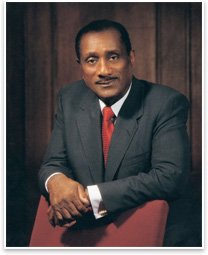 John H. Johnson
John H. Johnson Zevilla Jackson Preston, RA
Zevilla Jackson Preston, RA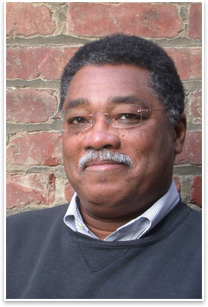 Michael E. Willis, FAIA
Michael E. Willis, FAIA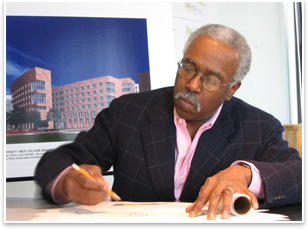 M. David Lee, FAIA
M. David Lee, FAIA
 “But what if she says: ‘I want a black architect?’ This
is what she would have to say and be committed to. We as black architects
must share a generous portion of the blame for our lack of exposure.
As a group, we must learn to become more vocal and political if we
are to be heard and therefore counted.”
“But what if she says: ‘I want a black architect?’ This
is what she would have to say and be committed to. We as black architects
must share a generous portion of the blame for our lack of exposure.
As a group, we must learn to become more vocal and political if we
are to be heard and therefore counted.”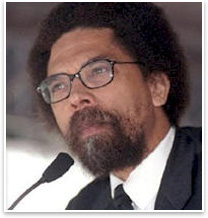 Professor Cornel West, who heads Princeton’s Program in African-American
Studies, points out in his book
Professor Cornel West, who heads Princeton’s Program in African-American
Studies, points out in his book 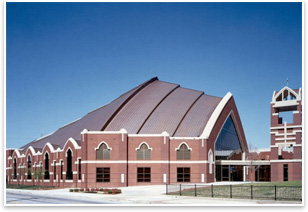 Churches step in
Churches step in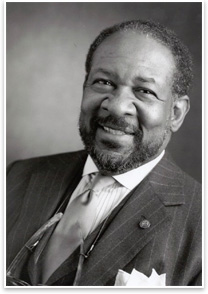 The public sector patronage base
The public sector patronage base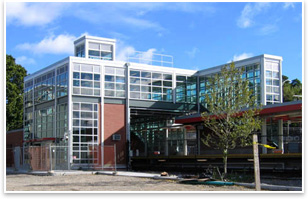 Yet there are times when you can break through this mindset and do
innovative designs, such as stations for the southwest corridor
of the Metropolitan Boston Transit Authority (MBTA), such as the
Savin Hill Station, pictured. But it took MBTA staff to create
a subgroup, which allowed firms such as Stull and Lee to develop
designs that differed from the prescribed norm.
Yet there are times when you can break through this mindset and do
innovative designs, such as stations for the southwest corridor
of the Metropolitan Boston Transit Authority (MBTA), such as the
Savin Hill Station, pictured. But it took MBTA staff to create
a subgroup, which allowed firms such as Stull and Lee to develop
designs that differed from the prescribed norm.